Drupal is an open-source content management system (CMS) designed to accommodate businesses of varying sizes, providing essential tools for content creation, website management, and user engagement. Drupal supports complex web solutions while remaining user-friendly for developers and content editors alike. When considering hosting Drupal, deploying it on Hetzner is a dependable choice due to its scalable infrastructure and user-friendly deployment solutions. ServerAvatar assists with Hetzner VPS and simplifies the deployment of the Drupal application on the Hetzner platform through easy steps.
Create a Server in Hetzner
Getting Started with Hetzner:
Hetzner provides a range of services like dedicated hosting, virtual private servers, colocation services, and domain registration. Hetzner is known for having reliable systems and competitive prices in web hosting. Its services work well for both individual users and businesses that need strong hosting options.
Step 1: Login to Hetzner Cloud Console
- Go to the Hetzner Cloud website and sign in using your credentials.
Step 2: Create a New Project (Optional)
- If you don't have an existing project, create a new one by clicking on the New Project button.
![]()
- Enter a name for your project and click Add Project.
![]()
Step 3: Select a Project
- Select the project in which you wish to create your server.
![]()
Step 4: Create a New Hetzner Cloud Server
- Navigate to the Servers sub-menu and click on Add Server to begin creating your server.
![]()
Step 5: Configure your server
-
Select a Location: Select the data center location where you want to deploy your server. Choose the region that is closest to your target audience for better performance.
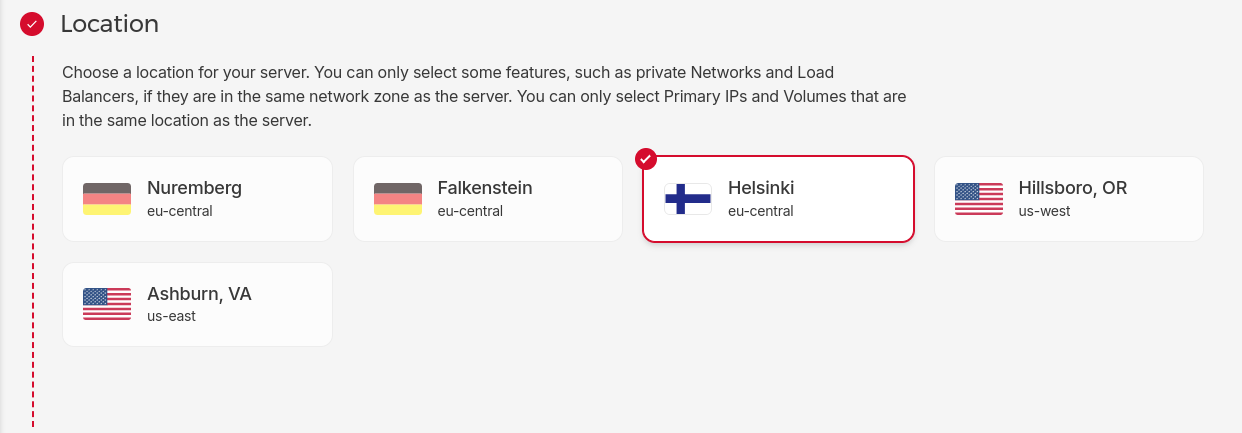
-
Select an Image: ServerAvatar supports both Ubuntu 20.04 and Ubuntu 22.04. Therefore, choose one of these supported operating systems.
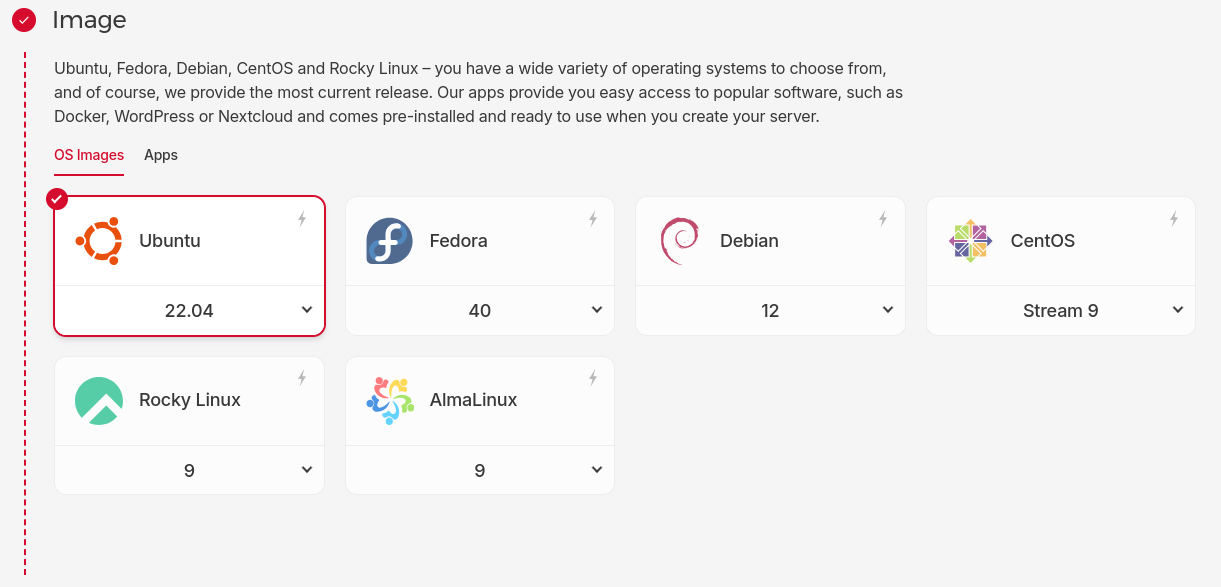
-
Select a Server Type: Hetzner provides various plans with different configurations of CPU, RAM, and storage. Select the server type based on your requirements. We recommend the minimum configuration of 2GB of disk space for hosting Drupal. You can select another plan of higher configuration based on your specific requirements and usage.
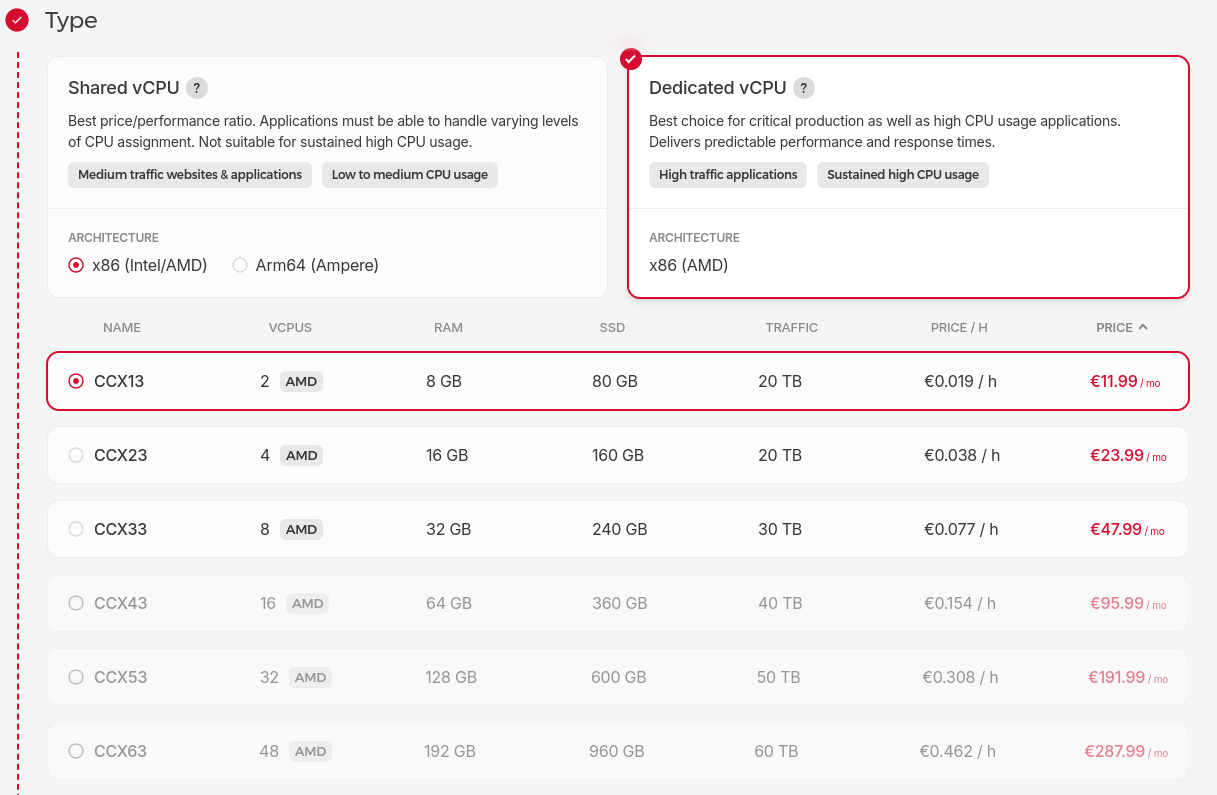
-
Select Networking: Select from three networking options for your server. Private networks allow you to securely connect servers within the same data center without going over the public internet.
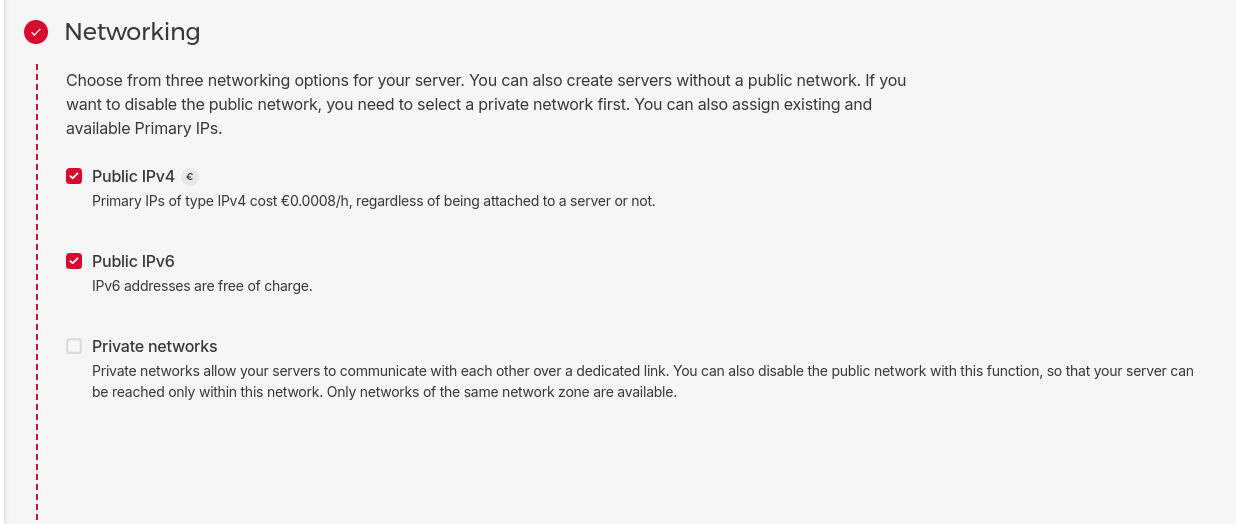
-
SSH Key or Root Password: Select an SSH Key if you want to authenticate with an SSH key. This method is recommended over using a root password for enhanced security. If you choose SSH key authentication, Hetzner will disable password-based authentication by default. Otherwise, you will receive the root password via email.
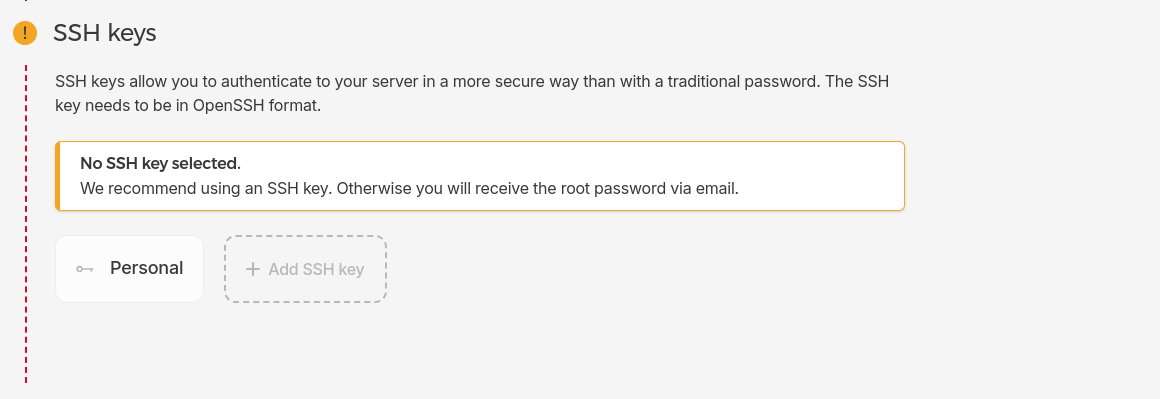
-
Add a Firewall Rule: Configure firewall rules to control incoming and outgoing traffic based on IP addresses, ports, and protocols for improved security.

- Additional Options (Optional): Configure additional options such as Backups, Placement Groups, Volumes, Labels, and Cloud Config as per your Requirements.
-
Give a Server Name: Enter a server name for easy identification.

-
Finalize and Create: Review your configuration settings to ensure that everything is configured correctly. Click on the Create & Buy Now button.9. Finalize and Create: Review your configuration settings to ensure that everything is configured correctly. Click on the Create & Buy Now button.
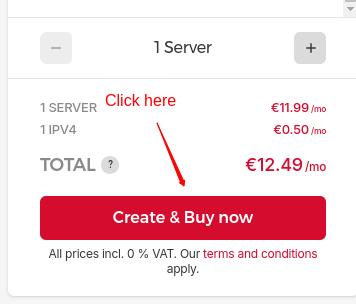
Step 6: Access Your Server
- Once the server is deployed, it will appear on your Hetzner Cloud dashboard. Use the provided IP address and SSH key (if configured) to access your server via SSH. Now, You can connect your Server with ServerAvatar for Server management.
![]()
Initial Server Configuration
The Initial server configuration includes the installation and configuration of various packages required to host your website. Usually, You have to write commands and modify configuration files. Luckily, With ServerAvatar, Your full server configuration and optimization can be automated.
Here are the three ways to automatically configure your server with ServerAvatar.
Connect a server using a direct method
- Login/Register to ServerAvatar account, click the Create button from the right side of the screen, and select Server from the dropdown.
- Select Direct Method in the serve connecting method section.
- Type the Server Name as per your choice.
- Select a Tech Stack as per your need. You can either select Apache, Nginx, OpenLiteSpeed or Node Stack.
- Select a Database: MySQL, MariaDB or MongoDB.
- Enable the toggle if you want to install the latest LTS version of node.js on your server.
- Select a Management plan and click the Connect Now button.
- You’ll see the command on your screen. Login to your server using an ssh connection and execute that command as a root user.
- The server connection process will be started on your ServerAvatar account after executing the command.
Connect a server using integration
- Login/Register to your ServerAvatar account, navigate to the Integration tab from the sidebar of the panel, and access Cloud Platform from the dropdown.
- Now Select a cloud platform you want to link with ServerAvatar.
- The popup form will appear on your screen. Enter details to link your cloud provider account. The integration method is different based on the cloud provider you select.
- You can integrate five different cloud provider platforms with ServerAvatar, which is-
Check the above link of cloud platforms to know more about integrating cloud platforms with ServeAvatar.
Connect a server using commands
Step 1. Login to your server using root user
Once you create a server as per your requirements, connect to your server using an ssh connection and execute the below three commands as a root user in your server console area.
wget https://srvr.so/install
chmod +x install
./install
Step 2. Select a web server
It will ask you which web server you would like to install on your server: Apache, Nginx, OpenLiteSpeed or Node Stack. Type anyone that you would like to install on your server and hit the enter button.
Step 3. Claim your server
Completing the process will give you a link to claim your server.
Open the link on your browser to access the ServerAvatar server panel.
Install and Setup Drupal CMS with ServerAvatar
Step 1: Download the Drupal Latest Release Zip file
Visit Drupal's official site and Download Drupal Latest release zip file. You can see the download page in the following image.
![]()
Step 2: Create a PHP Application
On the server panel, access the Application tab from the sidebar and click the Create button, as shown in the image below.
![]()
Next, fill in the required details to create an application, including the Application Name and Domain Name.
The latest version of Drupal runs on PHP version 8.1. So to change the version, check the Show Advanced Options box and change the PHP version of your application like the below image.
![]()
Note That:
If you want to host Drupal CMS on your domain, then make sure to point your domain to the current IP address of your server, and for that:
-
Log in to your hosting provider site, where you buy your domain. You can check your domain information with one click.
-
Access DNS Manager to edit your DNS records(contact the support team if you don’t find them)
-
Change the IP address of A Record of your website to the current server’s IP address.
Click the Create Application button after filling in the required details.
Step 3: Create a Drupal Database
On the server panel, Click the Database tab from the sidebar to create a MySQL database for Drupal.
![]()
ServerAvatar will create a database by filling in database details, including Database Name, Username, and Password.
![]()
Once you are done, Click the Create Database button, and ServerAvatar will create your database in seconds.
Step 4: Upload the Drupal Zip file
ServerAvatar has a built-in File Manager feature, so you won't need FTP clients to manage files.
To Upload a zip file on your application, go to the application panel of your created application in step 2 and click the File Manager tab.
Delete the index.html directory
Now access the public_html directory and delete the index.html directory to avoid forbidden errors on the site.
![]()
Upload Drupal Zip file
After deleting the file, it’s time to upload the Drupal zip file to the public_html directory. And for that, Click on the upload icon or Drag and Drop the zip file from your system.
![]()
Uncompress the Zip file
Unzip/Uncompress the uploaded Zip file in the public_html directory like the following image.
![]()
Delete the zip file after successfully uncompressed.
Move files to the public directory
Click on the folder created in the public_html directory where all the files are located. Select all files, including hidden files, and move them to the public_html folder.
![]()
Step 5: Install SSL Certificate
SeverAvatar allows you to install automatic SSL certificates with one click to keep users' data secure and verify your site ownership.
To install SSL on your website, click the SSL Certificates tab from the application panel.
![]()
Click the Automatic Installation button like the above image. You can also ensure Force HTTP to HTTPS to secure the communication between the browser and your website.
Step 6: Install and Setup Drupal
Open the URL of your application on the web browser. The setup page will appear like the following image.
Choose language
Drupal supports more than 100 languages.
![]()
Choose the one you want for your site and click the Save and Continue button.
Choose Profile
Select a profile from the given three installation profiles.
![]()
It would be recommended to Install the Standard profile and click the Save and continue button.
Verify Requirements
It verifies your site requirements and redirects to the next step if everything is fine.
Set up database
Enter the database credentials that we have created in step 3. It includes the database name, database user, and password.
![]()
Advanced Options include-
- Host: leave this field as it is if your database is hosted on the same server as an application
- Port Number: 3306 is recommended for MySQL/Aurora/MariaDB
- Table Name Prefix: Enter the database table name prefix as your choice
Click the Save and continue button.
Install Site
It can proceed to install Drupal on your site if all the information is correct. It’ll show you the installation status like the following image.
![]()
Configure Site
Site Information
Enter your site information, including-
- Site Name: Enter the name of your site as you want.
- Site Email Address: Automated emails related to the site, including reset password and registration details, will be sent from this email.
![]()
Site Maintenance account
Enter a Special user account information that can perform account-level tasks such as making backups and applying site updates. The account you set up has full administrative privileges.
![]()
- Username: Enter a username that is used for logging in to the Drupal Administrative interface
- Password: Enter the password for the admin login
- Email Address: Ente admin email address
Regional Settings
Enter the regional-specific information, including-
![]()
- Default Country: Select the name of your country.
- Default Time Zone: Select a time zone based on your location
Tick all the boxes under the Update Notification section to automatically check for updates and receive notifications.
Click the Save and continue button after filling in the required details.
Step 7: Drupal Admin panel
Completing all the above steps results in access to the Drupal admin panel, which looks like the following image.
![]()
That’s it. Now you can create an intuitive website or complex web application easily with a few clicks.